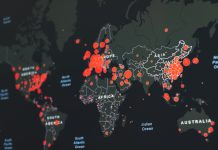With the news that the Doomsday Clock still sits at 23:57, humanity remains in serious danger of potential extinction. The news came on January 26 that the symbolic clock face, which represents how close humanity is to possible global catastrophe (the stroke of midnight), will not change from the time set in 2015.
According to Dr. Lawrence Krauss of the nonprofit Bulletin of the Atomic Scientists, who maintain the clock and meet biannually to discuss the existential threats facing humanity, “unless we change the way we think, humanity remains in serious danger.”
The Bulletin of the Atomic Scientists is composed of environmental scientists, physicists, and 18 Nobel Laureates, all of whom determine how the minute hand on the clock moves. This is a king’s ransom of experts.
Why The Hell Is There A Doomsday Clock Anyway?

In 1945, scientists involved in the Manhattan Project founded the publication as The Bulletin of the Atomic Scientists of Chicago, a nontechnical academic journal that covered global security and public policy issues related to the dangers of nuclear weapons.
They were initially concerned with the effects of the atomic bombings of Nagasaki and Hiroshima in Japan at the end of the Second World War.
Since 1947, the journal has annually run the Doomsday Clock as a representation of how close humanity was to possible global catastrophe, and by extension, possible extinction as a result. The first clock was set at 23:53, seven minutes from midnight, which represented the point of potential global catastrophe.
Sixty years later, the journal added global climate change as a legitimate existential threat to humanity. Emerging technologies and disease are also considered.
Possible Catastrophe And Extinction As A Passage Of Time
Since the initial 23:53 setting in 1947, the time on the Doomsday Clock has been changed 21 times:
- 1949: The Soviet Union held its first atomic bomb test, starting the nuclear arms race between them and the United States. The time on the Doomsday Clock was moved ahead to 23:57.
- 1953: The Doomsday Clock was pushed ahead an additional minute to 23:58, thanks in part to the United States and the Soviet Union testing thermonuclear devices within nine months of each other. This is the closest the clock has been to midnight since its inception.
- 1960: Thanks to increased scientific cooperation, increased public understanding of the dangers of nuclear weapons, and cooperation between the United States and the Soviet Union, the Doomsday Clock is rolled back for the first time, setting to 23:53.
- 1963: The United States and the Soviet Union agree to limit atmospheric nuclear testing and the Doomsday Clock is rolled back another five minutes to 23:48.
- 1968: Regional wars, including Vietnam, the Six-Day War, and the Indo-Pakistani War of 1965, rage. France and China, who have not agreed to limit atmospheric nuclear testing, develop nuclear weapons programs and assert themselves as global players in the nuclear arms race. The clock is pushed forward five minutes to 23:53.
- 1969: Every nation around the world, save for India, Pakistan, and Israel, sign the Nuclear Non-Proliferation Treaty, pushing the Doomsday Clock back to 23:50.
- 1972: The clock is pushed back two minutes, to 23:48, as the United States and Soviet Union sign the Strategic Arms Limitation Treaty (SALT I) and the Anti-Ballistic Missile Treaty.
- 1974: The clock now reads 23:51 as India tests Smiling Buddha, a nuclear device, and SALT II talks between the United States and Soviet Union stall as both nations modernize MIRV ballistic missiles.
- 1980: Talks between the United States and the Soviet Union are still deadlocked and with a burgeoning conflict between the USSR and Afghanistan, there is no end in sight. The U.S. Senate refuses to ratify the SALT II agreement and President Jimmy Carter considers both withdrawing the United States from the 1980 Olympic Games in Moscow and how to win a nuclear war. The time on the Doomsday Clock is moved ahead two minutes, to 23:53.
- 1981: Ronald Reagan becomes President of the United States and scraps further arms reduction talks with the Soviet Union. He decides the only way to end the Cold War is to win it. The fear of mutually-assured destruction escalates. Meanwhile, the Soviet Union continues its war with Afghanistan. The Doomsday Clock is pushed forward another three minutes, now reading 23:56.
- 1984: The Doomsday Clock is pushed ahead another minute, to 23:57, due to escalating tensions between the United States and the Soviet Union. The Soviet War with Afghanistan begins to “heat up” the Cold War. The United States deploys ballistic and cruise missiles in Western Europe. Ronald Reagan intensifies the arms race between the United States and the Soviet Union, who, along with their allies (except for Romania) boycott the Los Angeles Summer Olympics in retaliation for the United States’ 1980 boycott.
- 1988: Three minutes are docked from the Doomsday Clock as relations between the United States and the Soviet Union improve with the signing of the Immediate-Range Nuclear Forces Treaty. The clock now reads 23:54.
- 1990: With the fall of the Berlin Wall and the Iron Curtain, as well as the unification of Germany, the Doomsday Clock is pushed back four minutes to 23:50.
- 1991: The Doomsday Clock is pushed back an additional seven minutes to 23:43 as the United States and Soviet Union sign the Strategic Arms Reduction Treaty. The Soviet Union dissolves. This is the furthest away from midnight the Doomsday Clock has been at any point during its existence.
- 1995: The Doomsday Clock starts moving toward midnight again, adding three minutes in response to global military spending continuing at Cold War levels amid concerns about post-Soviet nuclear proliferation of weapons and brainpower. It now reads 23:46.
- 1998: Both the United States and Russia run into difficulties reducing their nuclear stockpiles while India and Pakistan test nuclear weapons in a tit-for-tat show of aggression. The Doomsday Clock is pushed forward another five minutes to 23:51.
- 2002: Very little progress has been made when it comes to global nuclear disarmament and the United States not only rejects a series of arms control treaties, but threatens to withdraw from the Anti-Ballistic Missile Treaty, citing concerns about the possibility of nuclear terrorist attacks due to the amount of weapons-grade nuclear materials unsecured and unaccounted for worldwide. The Doomsday Clock is pushed forward another two minutes, reading 23:53.
- 2007: North Korea tests a nuclear weapon in October 2006, Iran begins making strides in its nuclear program, the United States renews emphasis on the military utility of nuclear weapons, and attempts to adequately secure nuclear materials fails. The United States and Russia still have 26,000 nuclear weapons between them. Climate change is added as one of the greatest existential threats to humankind. The Doomsday Clock is pushed two minutes closer to midnight, now reading 23:55.
- 2010: The Doomsday Clock is pushed back one minute, to 23:54, due to worldwide cooperation to reduce nuclear arsenals and combat global climate change. The New START agreement is ratified by both the United States and Russia with additional nuclear arsenal reduction negotiations planned for the future. At the 2009 United Nations Climate Change Conference, developing and industrialized nations formally take responsibility for carbon emissions and resolve to limit the global temperature rise to 2 degrees Celsius.
- 2012: The minute taken away in 2010 is added back, bring the Doomsday Clock to 23:55 again, as there is a fundamental lack of global political action to address global climate change, reduce nuclear stockpiles, regulate nuclear power safety, and address the potential for regional nuclear conflict.
- 2015: Two more minutes are added to the Doomsday Clock, bringing the time to 23:57. There are continued concerns regarding the lack of global political action to address global climate change and the regulation of nuclear waste. Both Russia and the United States announce plans to refurbish and modernize their nuclear stockpiles.
What Does Maintaining 23:57 Mean For Us?
Dr. Krauss has stressed that “action now can reduce these threats, but only if we recognize them honestly and face them head-on.” With the possibility of human extinction attached to the existential threats considered by the Bulletin, the fact that the clock has maintained at only three minutes from midnight is still grave news.
Despite the United States reaching a nuclear deal with Iran and the progress made at the Paris accord concerning climate change, rising tensions between the United States and Russia, including their projects to refurbish nuclear stockpiles, and North Korea’s relentless pursuit of joining the nuclear weapons club balanced out the progress.
It’s probably not unreasonable to assume that had Congressional Republicans and Israeli Prime Minister Benjamin Netanyahu gotten their way in trashing the nuclear deal with Iran, the clock may have inched one minute closer to midnight, tying 2016 with 1953 as the years in which the Doomsday Clock was closest to the end.
On the subject of climate change, even though the Paris accords were successful, the brazen American Congress is still controlled in both houses by men and women who do not believe climate change is even a thing, much less influenced by human industrial activities.
Moreover, even with the Iran nuclear deal in effect under this administration, the outcome of the 2016 Presidential election may influence whether or not the clock ticks one minute closer to midnight.
At the end of the day, I’m not sure I trust the American government to do everything in their power to keep the clock from striking midnight for the first time in its history.
But more on that later…




